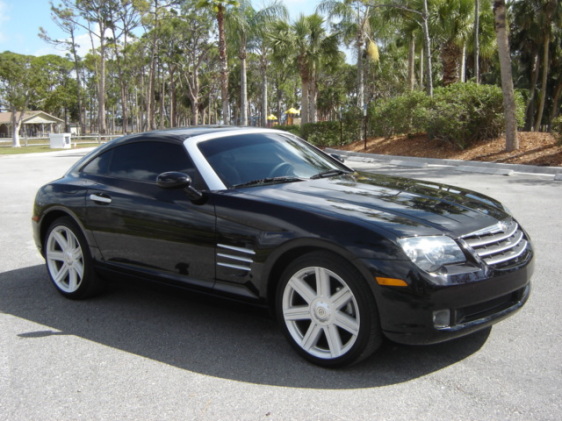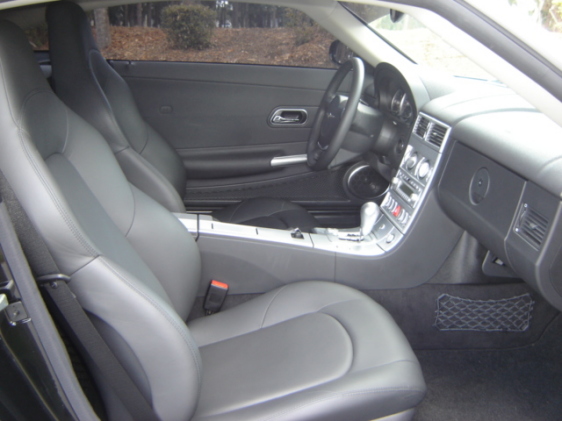
The still head-turning Chrysler Crossfire, introduced in 2004, was the first much anticipated result of the Daimler/Chrysler merger. And it surely was an intriguing blend of German engineering and American style.
Produced through the 2008 model year, this 2-seat coupe or roadster convertible was primarily based on the Mercedes SLK. Initially, the Chrysler Crossfire was only offered as a coupe. The convertible made its debut for the 2005 model year.
But with only 80,000 sold here, they are getting harder to find in good condition with each passing year. But that said, some gems continue to pop up as many owners didn't use them as their everyday cars, resulting in lower mileage examples (75,000 or less) to be found out there, although you may need to expand your geographic search to locate them.
And clearly, after all these years, prospective buyers must be aware of the possible mechanical issues to be aware of before buying.
So here, ...
- First, we'll look at what history has proven about the reliability of the Chrysler Crossfire.
- We'll then list its possible mechanical issues as reported by owners so they can be checked before buying one today.
- Then we'll do an overview of its features and characteristics so potential buyers can get to know the vehicle better.
- And then we'll follow that with "Things To Do When Considering An Older Crossfire".
Chrysler Crossfire Reliability
The Chrysler Crossfire, produced between 2004 and 2008, is known for its unique design and shared engineering with the first-generation Mercedes-Benz SLK. This collaboration led to a mix of Chrysler and Mercedes components, contributing to both its strengths and weaknesses in terms of reliability.
History has proven that the Crossfire's reliability is average to below average compared to other vehicles in its class. However, with proper maintenance and care, many owners have reported high mileage without major issues.
Reliability ratings:
J.D. Power: 2.5/5 (2004), 3/5 (2005-2007), 2/5 (2008)
Edmunds: 3.5/5 (2004-2007), 3/5 (2008)
Kelley Blue Book: 3.5/5 (2004-2007), 3/5 (2008)
Mechanical Reliability: The Crossfire's engine and transmission, borrowed from Mercedes, are generally reliable if well-maintained.
Maintenance Costs: Because of its European parts, maintenance and repairs can be pricier than typical American vehicles. However, routine maintenance can keep the car running smoothly.
Longevity: With proper care, a Chrysler Crossfire can last over 150,000 miles, with some owners reporting over 200,000 miles. The longevity largely depends on how well the vehicle has been maintained.
Durability: The build quality is solid, especially for a car in this price segment, but wear and tear on the interior and exterior can be more noticeable due to its age and the materials used.
Overall, the Chrysler Crossfire can be a reliable and potentially long-lasting car if you're willing to invest in its maintenance and handle the occasional costlier repair.
Chrysler Crossfire Possible Mechanical Problems

As reported by owners, the Crossfire can encounter several mechanical issues over time, particularly due to its age and the combination of Chrysler and Mercedes components. Here are some common mechanical problems which should be included in an inspection before buying:
Engine Cooling Problems: Some Crossfire owners have reported issues with the cooling system, including radiator leaks or thermostat failures. Overheating can be a concern if these issues aren't addressed promptly.
Transmission Shifting Problems: The Crossfire uses a Mercedes-Benz 5-speed automatic transmission (NAG1), which is generally reliable. However, issues such as harsh shifting or transmission fluid leaks can occur, especially if the transmission hasn't been regularly serviced.
Mass Air Flow (MAF) Sensor: The MAF sensor, which measures the amount of air entering the engine, can fail and cause poor engine performance, including rough idling or hesitation during acceleration.
Electrical System: The Crossfire has been prone to electrical gremlins, such as issues with the power windows, central locking system, or malfunctioning sensors.
Instruument Cluster: The digital display on the instrument cluster may develop issues, including fading or complete failure of the display.
Throttle Body: The electronic throttle body can sometimes malfunction, leading to poor throttle response or the car entering "limp mode," where the engine power is reduced to protect it from further damage.
Suspension Wear: The Crossfire's suspension components, such as control arm bushings and ball joints, may wear out faster than expected, especially if the car is driven aggressively or on poor road conditions.
Steering Rack: Some owners have reported leaks in the steering rack, which can lead to steering stiffness or fluid loss. This can be a costly repair if not addressed early.
Brake Calipers: There have been reports of caliper issues, such as sticking, which can lead to uneven brake wear or reduced braking performance.
Catalytic Converter: The catalytic converter can fail over time, leading to reduced engine performance and increased emissions. Replacing it can be expensive.
Exhaust Leaks: Exhaust leaks, particularly from the exhaust manifold or gaskets, can cause loud noises and reduced engine efficiency.
Fuel Pump: The fuel pump can fail, leading to starting issues or the engine stalling. This is a relatively common issue in older vehicles.
Fuel Injectors: Clogged or failing fuel injectors can lead to poor engine performance, misfires, and reduced fuel efficiency.
Of course, these issues are not universal and can vary depending on the car's maintenance history and how it has been driven. Regular maintenance and proactive repairs can help prevent many of these problems, or their severity.
Chrysler Crossfire Overview

Under the hood, the standard engine during the entire production run was a Mercedes 3.2-liter six-cylinder with an output of 215 horsepower and 229 pound-feet of torque. Crossover shoppers have a choice in transmissions of either the standard 6-speed manual or the optional 5-speed automatic.
Of particular interest to many is the Crossfire SRT-6 which was produced for just two model years, 2005 and 2006. Powering the SRT-6, and mated with a sport-tuned suspension and a 5-speed automatic transmission, was a supercharged engine that was good for a healthy 330-horsepower. This version of the Crossover has serious straightline performance. It should be noted, however, that this added performance does make the ride a bit rougher.
Chrysler Crossfire shoppers should also note that thare was only one trim level available in 2004 and it included leather upholstery and was generally quite well-equipped with other standard features, including full power accessories, heated and power front seats (8-way driver, 4-way passenger), heated outside mirrors, dual-zone climate control, one-touch power windows, a leather steering wheel, a telescopic steering column, heated front windshield jets, a rear anti-roll bar, four-wheel antilock brakes with BrakeAssist, side airbags, traction control, stability control, and a 240-watt 6-speaker audio system with an in-dash CD player.
For 2005, the Crossfire was available in base and Limited trims. The base then came with cloth upholstery and a reduced number of standard features, while the Limited added such features as the power and heated leather seats, an upgraded 8-speaker Infinity sound system, additional sound insulation, a tire-pressure monitor, and a number of upgraded trim accents.
Used Crossfire Limited shoppers should also note that some of these models can be found with the optional DVD-based navigation system.
In addition to its engine and suspension upgrades, the SRT6 also came with 18-inch front wheels and 19-inch rear wheels along with pearl leather seats with suede inserts.
Also found in the market are base models with the optional Special Edition package which was available for the 2006 and 2007 model years. It included exterior Inferno Red Crystal Pearl paint, a black windshield surround, Dark Slate Gray cloth upholstery, SRT6-like cast-aluminum wheels, and satin silver door handles and side louvers.
For 2008, its last year of production, the Crossfire came in just the Limited trim.

Gas mileage for the Crossfire is an EPA-estimated 17 mpg city and 25 on the highway with the manual transmission and 21 city and 28 highway with the automatic. Fuel economy for the SRT-6 comes in at 17 and 24, respectively.
Standard safety features on all Crossfires include side airbags, antilock brakes with brake assist, stability control and traction control, while a tire pressure monitor is standard on the Limited.
What are some of the Crossfire's cons?
Sadly, while the Chrysler Crossfire debuted with great styling and a lot of potential, many of its problem areas were not addressed over the years. Both the aged recirculating-ball steering and 215-hp V6 were simply not very competitive in this segment, meaning its handling is simply subpar in this sporty segment. What's more, the ride quality can be fairly harsh, particularly in the SRT-6.
And in addition to a cramped interior, its cabin design was also a bit dated for the time, looking more like what we might expect in even earlier models. We have to remember that the Crossfire found its origin from the Mercedes SLK which debuted in 1997.
And other cons would include limited rear visibility and small trunk space.
On the plus side, the pros:
Its German genes have carried over into a solidly built car. And while the steering system may leave something to be desired, it nevertheless has great road grip when cornering. The car's acceleration is about on par for the segment, while the straight-line performance of the SRT-6 is downright blazing.
And of course, there's the head-turning design that is truly sports car-like, while its now relatively inexpensive price tag is another appeal. It also has a fairly smooth shifting transmission.
 By Josh Rosenberg
By Josh Rosenberg